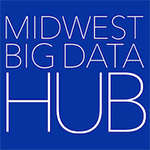By Raleigh Butler
We’ve all heard the old adage that if you don’t like the weather in the Midwest, wait a minute and it will change. So how can we possibly forecast conditions weeks in advance?
In 2019, an NSF collaborative grant was awarded to six institutions to sponsor the study of sub-seasonal climate forecasting (SSF)—with machine learning (ML). This topic addresses three core themes of the Midwest Big Data Innovation Hub—resilient communities, digital agriculture, and cyberinfrastructure. A project of the NSF Harnessing the Data Revolution (HDR) program, this award was to researchers at the following six universities: University of Minnesota–Twin Cities, University of Chicago, University of Wisconsin–Madison, Carnegie Mellon University, George Mason University, and the University of Illinois at Urbana-Champaign.
What is Sub-Seasonal Climate Forecasting?
Sub-seasonal climate forecasting focuses on predicting weather 2–8 weeks away. Interestingly, this is an area of higher difficulty than other types of forecasting. As the research team states on its website, “SSF is considered more challenging than either weather forecasting or even seasonal forecasting.” This effort ties ML together with agriculture in an effort to make these difficult predictions.
Computing’s Place in Forecasting
What is ML compared with deep learning (DL)? Machine learning builds methods for machines to “learn” or change their procedures based on input over time. Deep learning is a specific type of ML and is based on how the human brain operates.
In the linked article below from the SSF team, some difficulties in building models are discussed. Many of these difficulties are tied to the relationship between ML and physics. Therefore, systems have been created for physics-guided ML and ML-enhanced physics. Here’s what some of these systems take into account to overcome the difficulties:
- • Physics-guided ML takes physics into account to produce output (such as forces affecting movement of clouds, gravity in rainfall, etc.). Unfortunately, existing data that includes physics-related information is limited.
- • The other approach is ML-enhanced physics. One example of this, among many, is the Monte Carlo Tree Search (MCTS). The MCTS works by applying a hierarchical partition tree to the data. By using this approach, the program follows the sub-“branches” that are most likely in a given situation to produce a prediction. In short, the MCTS works as a decision tree and is optimized to predict the most likely path down each branch with each decision. A visual is provided in the image below.

Sub-Seasonal Agriculture
How does this tie into agriculture? First, we will examine the key planning that takes place during sub-seasonal periods. According to a graph on the SSF project site, these are some important decisions that are made during those periods:
- • Maritime Planning: Designate ship routing
- • Agriculture: Schedule planting
- • Agriculture: Irrigate and apply nutrients
- • Emergency Management: Pre-stage emergency supplies
- • Aviation: Plan evacuations and sorties
- • Water Resources: Manage reservoir levels for flood control
- • Energy: Plan for spikes in energy demand
Making these decisions is a delicate process; there is a high price to pay if predictions are incorrect. Increasing the ability to accurately forecast sub-seasonally is, of course, monetarily valuable; however, it is also valuable in terms of product production and delivery.
These studies have resulted in several scientific publications since the conclusion of the funding. One of these papers, published by many team members of the original study, is published here (available for download as a pdf). The paper, published in June 2020, discusses challenges, analyses, and advances associated with ML climate forecasting. The paper includes several diagrams of how various models predict sub-seasonal weather differently. The models also discuss forecasting in various climate zones (over the ocean, and different areas over land).
Scientists are still collecting data to use as input for the models and to increase accuracy. As mentioned, this area of forecasting is more difficult than forecasting over time horizons that are nearer or further away. Although climate prediction may still be difficult, there is progress being made in the field. The paper mentioned above states, “Overall, XGBoost and Encoder (LSTM)-Decoder (FNN) perform the best. Qualitatively, coastal and south regions are easier to predict than inland regions (e.g., Midwest).”
Get Involved
Learn more about the SSF project on their site.
Contact the Midwest Big Data Innovation Hub if you’re aware of other people or projects we should profile here, or to participate in any of our community-led Priority Areas. The MBDH has a variety of ways to get involved with our community and activities. The Midwest Big Data Innovation Hub is an NSF-funded partnership of the University of Illinois at Urbana-Champaign, Indiana University, Iowa State University, the University of Michigan, the University of Minnesota, and the University of North Dakota, and is focused on developing collaborations in the 12-state Midwest region. Learn more about the national NSF Big Data Hubs community.
